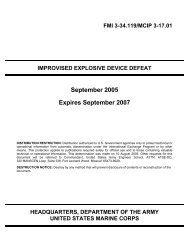FM 4-0, Sustainment - GlobalSecurity.org
FM 4-0, Sustainment - GlobalSecurity.org
FM 4-0, Sustainment - GlobalSecurity.org
- No tags were found...
You also want an ePaper? Increase the reach of your titles
YUMPU automatically turns print PDFs into web optimized ePapers that Google loves.
Functions of <strong>Sustainment</strong>include mortuary affairs collection points (MACPs), theater mortuary evacuation points, mortuary affairsdecontamination collection points, temporary interment sites, ID laboratories, and a port mortuary.5-26. When directed by the CCDR, MA units establish cemeteries and provide for temporary interment ofremains. MA units may also operate in-theater mortuaries, but they require personnel and equipmentaugmentation or HNS for embalming and other procedures (see JP 4-06 and <strong>FM</strong> 4-20.64).5-27. A process and location for evacuation of personnel remains and equipment must be established. Theresponsibility for manning and running this activity must be done by the service responsible for the theater andhave coordination and automation capability to process actions in the personnel automation systems as well aslogistical systems. All personnel have clothing and other issue documents that must be cleared as well aspersonal effects that must be inventoried, cleaned, disposed of, and entered back into the system for issue. Thisis normally done by units, but also done at the Joint Personnel Effects Depot for those killed in action as well aswounded in action that have been evacuated and separated from their equipment.TRANSPORTATION5-28. Army transportation units play a key role in facilitating force projection and sustainment. Armytransportation ensures that Army and joint forces that are projected globally are able to be sustained inoperations. Transportation operations encompass the wide range of capabilities provided by transportation unitsand Soldiers. In joint operations, Army transportation units provide the full range of capabilities needed toallow joint and Army commanders to achieve operational objectives.FUNDAMENTALS OF TRANSPORTATION MANAGEMENT5-29. The Army transports personnel, cargo, and equipment by motor, rail, air, and water with <strong>org</strong>anic orcontract assets. While each situation may not be conducive to using a particular mode, the Army must be ableto manage, operate, and supervise these modes of transport. Mode platforms include trucks, trains, containers,flatracks, watercraft, aircraft, and host nation assets. To successfully execute force projection operations andextend operational reach and endurance, Army transportation units must execute the following functions:movement control, terminal operations, and mode operations (see <strong>FM</strong> 55-1).Movement Control5-30. Movement control is the planning, routing, scheduling, controlling, coordination, and in-transit visibilityof personnel, units, equipment, and supplies moving over line(s) of communication (LOC) and the commitmentof allocated transportation assets according to command planning directives. It is a continuum that involvessynchronizing and integrating sustainment efforts with other programs that span the spectrum of militaryoperations. Movement control is a tool used to help allocate resources based on the CCDR’s priorities and tobalance requirements against capabilities (<strong>FM</strong> 4-01.30).5-31. The five basic principles of movement control provide a basis for all transportation operations. Theseprinciples are:• Centralized Control and Decentralized Execution. Centralized Control means that a focal pointfor transportation planning and resource allocation exists at each level of command involved in anoperation. Decentralized execution of transportation missions means terminal and mode operatorsremain free to assign and control the specific transportation assets that will meet the requirement.• Regulated Movements. Movement control authorities regulate moves to prevent terminal and routecongestion and scheduling conflicts among Service components.• Fluid and Flexible Movements. Transportation systems must provide the uninterrupted movementof personnel, supplies, and services. To do this, the system must be capable of rerouting anddiverting traffic.• Effective Use of Carrying Capacity. This principle is simple: keep transportation assets fullyloaded and moving as much as the tactical situation permits.30 April 2009 <strong>FM</strong> 4-0 5-5

















